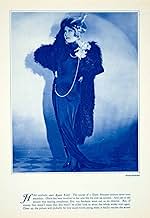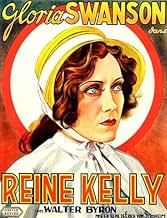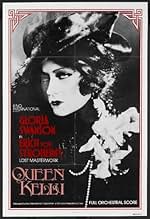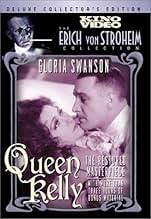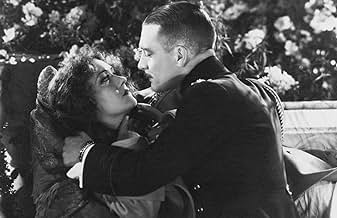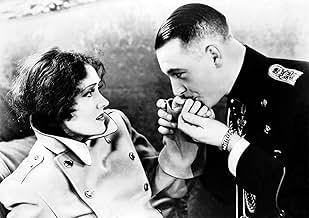IMDb RATING
7.1/10
3.4K
YOUR RATING
A convent girl is abducted and seduced by a prince before being sent off to a brothel in East Africa.A convent girl is abducted and seduced by a prince before being sent off to a brothel in East Africa.A convent girl is abducted and seduced by a prince before being sent off to a brothel in East Africa.
- Directors
- Writers
- Stars
- Awards
- 1 win total
Sylvia Ashton
- Kelly's Aunt
- (uncredited)
Wilson Benge
- Prince Wolfram's Valet
- (uncredited)
Sidney Bracey
- Prince Wolfram's Lackey
- (uncredited)
Rae Daggett
- Coughdrops
- (uncredited)
Robert Frazier
- Catholic Priest
- (uncredited)
Florence Gibson
- Kelly's Aunt
- (uncredited)
Madge Hunt
- Mother Superior
- (uncredited)
Tully Marshall
- Jan Vryheid
- (uncredited)
Ann Morgan
- Maid Escorting Kelly to Altar
- (uncredited)
Madame Sul-Te-Wan
- Kali Sana - Aunt's Cook
- (uncredited)
Lucille Van Lent
- Prince Wolfram's Maid
- (uncredited)
Wilhelm von Brincken
- Prince Wolfram's Adjutant
- (uncredited)
Gordon Westcott
- Lackey
- (uncredited)
- Directors
- Writers
- All cast & crew
- Production, box office & more at IMDbPro
Featured reviews
This is Director Eric Von Stroheim's last film, produced by it's star, Gloria Swanson. There is much to be learned from the commentaries and additional features on the deluxe Kino DVD of this silent film. The film itself is a wonderful lesson in film-making of its period. Von Stroheim loved to take shots of all the props and costume details of a character believing that this focus on detail told you more about the character than the actor alone could convey. This technique was later perfected by Hitchcock, where details shots are followed by reaction shots to move the story and emotional life along.
QUEEN KELLY is the story of a convent girl who falls in love with a dissipated prince who is promised to a debauched Queen. By today's standard, Seena Owen's performance as the queen is laughably over the top; she slithers and glowers and when she's really angry, she seems to have something stuck in her eye. Swanson herself was the prototype of today's tiny body, big head build favored in television. In her long shots her build looks almost like a pygmy, especially in comparison to Owen. But Swanson has that riveting face, and remains really a fine actress. The interview sections done as introductions to a television viewing of QUEEN KELLY show her to have retained those gorgeous and expressive eyes. This was considered her last film as a real ingénue - she was a bit long in the tooth to be playing a convent girl - but that was the style, bless them.
The original story was only about 1/3 completed when the production went way over budget and delved into areas that would never be approved by censors. Arguably, given Seena Owen's almost 100% nude (wearing either chiffon negligee, or a strategically held cat) performance, most of it may not have passed censors.
The restoration makes much ado of finding reels from the abandoned "African brothel" sequences, but when all is said and done, the "Swanson Ending" (the only way it was shown after talkies had come in and silents were pretty much a done thing) is a very serviceable and good ending evoking Shakespearian tragedy. Most silents were big on action, short on story, with fairly simple plots. Granted the original was supposed to have a happy, if rather suspicious, happy ending, but this makes total sense, and makes Queen Kelly seem very complete.
The only real loss of the Swanson ending is losing the believably sick (in both senses of the word) performance of Tully Marshall. Between Owen and Marshall, it is a lesson in why the production "code of decency" was developed in the first place. The irony is that, as much as she may have been considered heavy handed or intrusive for firing Von Stoheim, Swanson's ending demonstrates that Swanson really did know what she was doing as a producer. A memorable and informative trip into film history.
If you're not interested in film history or silent film, skip it.
QUEEN KELLY is the story of a convent girl who falls in love with a dissipated prince who is promised to a debauched Queen. By today's standard, Seena Owen's performance as the queen is laughably over the top; she slithers and glowers and when she's really angry, she seems to have something stuck in her eye. Swanson herself was the prototype of today's tiny body, big head build favored in television. In her long shots her build looks almost like a pygmy, especially in comparison to Owen. But Swanson has that riveting face, and remains really a fine actress. The interview sections done as introductions to a television viewing of QUEEN KELLY show her to have retained those gorgeous and expressive eyes. This was considered her last film as a real ingénue - she was a bit long in the tooth to be playing a convent girl - but that was the style, bless them.
The original story was only about 1/3 completed when the production went way over budget and delved into areas that would never be approved by censors. Arguably, given Seena Owen's almost 100% nude (wearing either chiffon negligee, or a strategically held cat) performance, most of it may not have passed censors.
The restoration makes much ado of finding reels from the abandoned "African brothel" sequences, but when all is said and done, the "Swanson Ending" (the only way it was shown after talkies had come in and silents were pretty much a done thing) is a very serviceable and good ending evoking Shakespearian tragedy. Most silents were big on action, short on story, with fairly simple plots. Granted the original was supposed to have a happy, if rather suspicious, happy ending, but this makes total sense, and makes Queen Kelly seem very complete.
The only real loss of the Swanson ending is losing the believably sick (in both senses of the word) performance of Tully Marshall. Between Owen and Marshall, it is a lesson in why the production "code of decency" was developed in the first place. The irony is that, as much as she may have been considered heavy handed or intrusive for firing Von Stoheim, Swanson's ending demonstrates that Swanson really did know what she was doing as a producer. A memorable and informative trip into film history.
If you're not interested in film history or silent film, skip it.
I'd imagine that most people who would come to this page to read a review of Erich Von Stroheim's unfinished epic Queen Kelly already know something about it, but nonetheless it seems a little historical context is necessary before attempting to critique the fragment that remains. This was a deeply troubled project, memorably described by leading lady Gloria Swanson as a child that refused to be born. Set in a fictitious 'Middle European' kingdom, the first portion of Von Stroheim's screenplay tells a fairy tale-like story of an innocent convent girl, Patricia Kelly, who becomes involved with a wastrel Prince-- who, unbeknownst to her, is already betrothed to the Queen. At first the Prince wants only to toy with Kelly, but in the course of their one evening together he sincerely falls in love with her. Unfortunately, the mad Queen Regina learns of the affair and literally flogs Kelly out of the palace. Kelly attempts suicide, but is rescued and abruptly sent to German East Africa, where her dying aunt runs a brothel. She is forced to marry a syphilitic plantation owner and eventually winds up successfully running the brothel herself, under the ironic moniker "Queen Kelly."
As originally scripted this film might have run as long as five hours, so the portion available today represents barely one-third of the intended opus. The project marked the sole collaboration between writer/director Von Stroheim, star/producer Swanson, and co-producer Joseph P. Kennedy, patriarch of the political dynasty (who was also Swanson's lover at the time). Plans for this silent epic were launched at the end of 1927, but by the time shooting began in fall of 1928 the talkie revolution was sweeping Hollywood, and this would prove to be perhaps the biggest single factor that doomed the project to limbo. Three months into the filming Von Stroheim was fired, and for the next few years Swanson attempted to finish the movie in various ways, finally releasing a truncated version in Europe in 1932. In the 1960s about twenty minutes' worth of footage from the sequence set in Africa was discovered, and this material was reunited with the earlier portion in a restored version completed in 1985.
Given this history it seems almost unfair to critique what remains of Queen Kelly at all, but the restoration presents a rough idea of what the movie might have amounted to in its longer form. This is a fascinating fragment with both positive and negative aspects.
On the positive side, the film is beautiful to look at; Paul Ivano's gleaming cinematography ranks with the best work of the era. Practically every shot boasts features of striking interest, and the production design teems with the sort of character-revealing detail for which Von Stroheim was known. Befitting the unreal atmosphere, Seena Owen and Tully Marshall offer highly stylized character turns as Queen Regina and plantation owner Jan Vryheid. Owen's Mad Queen is unforgettable, lounging about the palace nude (while toting a strategically positioned white cat!), surrounded by erotic art and brandishing a riding crop. Marshall's scenes are limited to a few minutes in the recovered 'Africa' footage, but he etches a vivid portrait of creepy decadence.
On the debit side, however, is the central and insurmountable problem that Gloria Swanson was miscast in the title role: she simply isn't credible as the innocent convent girl the story demands. Kelly is supposed to be a sheltered girl who has never tasted champagne. Swanson was 31 years old when this film was made and, frankly, looked older. Even in films she made in her early 20s she comes off as a tough cookie who could handle anything, but here, alongside the actual girls who are supposed to be her contemporaries, Gloria looks like she should be playing the Mother Superior. Von Stroheim's leading lady from The Wedding March, 21 year-old Fay Wray, would have been perfect as Kelly, but once producer Swanson cast herself in the role the project was inherently flawed.
Another problem is that most of this material was edited together only after Von Stroheim had been fired and the production shut down, when Swanson was attempting to assemble a marketable feature-length movie out of the opening 'Middle Europe' section. Originally these scenes had been intended to serve as little more than a prologue to the Africa story, but since it was the only portion completed the editors were forced to extend what they had to pad the running time. There is much lingering over details and too many prolonged reaction shots, especially in the scenes between Kelly and the Prince. It's said that when Erich Von Stroheim saw this version of the film in later years he complained that the pace was far too slow, and so it appears today: sumptuously photographed but draggy, despite the occasional high points.
In sum, while I would call this film a must for silent movie buffs, I don't believe the average viewer would find much to enjoy in Queen Kelly. This is one of those legendary disasters with a "backstory" rather more interesting than what we see on screen. In that light I can especially recommend watching the recent DVD release with film scholar Richard Koszarski's commentary accompanying the visuals, to help make sense of it all.
As originally scripted this film might have run as long as five hours, so the portion available today represents barely one-third of the intended opus. The project marked the sole collaboration between writer/director Von Stroheim, star/producer Swanson, and co-producer Joseph P. Kennedy, patriarch of the political dynasty (who was also Swanson's lover at the time). Plans for this silent epic were launched at the end of 1927, but by the time shooting began in fall of 1928 the talkie revolution was sweeping Hollywood, and this would prove to be perhaps the biggest single factor that doomed the project to limbo. Three months into the filming Von Stroheim was fired, and for the next few years Swanson attempted to finish the movie in various ways, finally releasing a truncated version in Europe in 1932. In the 1960s about twenty minutes' worth of footage from the sequence set in Africa was discovered, and this material was reunited with the earlier portion in a restored version completed in 1985.
Given this history it seems almost unfair to critique what remains of Queen Kelly at all, but the restoration presents a rough idea of what the movie might have amounted to in its longer form. This is a fascinating fragment with both positive and negative aspects.
On the positive side, the film is beautiful to look at; Paul Ivano's gleaming cinematography ranks with the best work of the era. Practically every shot boasts features of striking interest, and the production design teems with the sort of character-revealing detail for which Von Stroheim was known. Befitting the unreal atmosphere, Seena Owen and Tully Marshall offer highly stylized character turns as Queen Regina and plantation owner Jan Vryheid. Owen's Mad Queen is unforgettable, lounging about the palace nude (while toting a strategically positioned white cat!), surrounded by erotic art and brandishing a riding crop. Marshall's scenes are limited to a few minutes in the recovered 'Africa' footage, but he etches a vivid portrait of creepy decadence.
On the debit side, however, is the central and insurmountable problem that Gloria Swanson was miscast in the title role: she simply isn't credible as the innocent convent girl the story demands. Kelly is supposed to be a sheltered girl who has never tasted champagne. Swanson was 31 years old when this film was made and, frankly, looked older. Even in films she made in her early 20s she comes off as a tough cookie who could handle anything, but here, alongside the actual girls who are supposed to be her contemporaries, Gloria looks like she should be playing the Mother Superior. Von Stroheim's leading lady from The Wedding March, 21 year-old Fay Wray, would have been perfect as Kelly, but once producer Swanson cast herself in the role the project was inherently flawed.
Another problem is that most of this material was edited together only after Von Stroheim had been fired and the production shut down, when Swanson was attempting to assemble a marketable feature-length movie out of the opening 'Middle Europe' section. Originally these scenes had been intended to serve as little more than a prologue to the Africa story, but since it was the only portion completed the editors were forced to extend what they had to pad the running time. There is much lingering over details and too many prolonged reaction shots, especially in the scenes between Kelly and the Prince. It's said that when Erich Von Stroheim saw this version of the film in later years he complained that the pace was far too slow, and so it appears today: sumptuously photographed but draggy, despite the occasional high points.
In sum, while I would call this film a must for silent movie buffs, I don't believe the average viewer would find much to enjoy in Queen Kelly. This is one of those legendary disasters with a "backstory" rather more interesting than what we see on screen. In that light I can especially recommend watching the recent DVD release with film scholar Richard Koszarski's commentary accompanying the visuals, to help make sense of it all.
I am going to address the Kino DVD of Queen Kelly because that is how I saw the film (which is probably true of most of the film's North American viewers). Queen Kelly is never going to resemble anything close to what its director Erich von Stroheim imagined. Therefore, any version is a compromise. There are two options as releases go. An abbreviated version of what was filmed of the script was released with a hasty ending shot at the request of star Gloria Swanson. This version is called the Swanson cut. The second version is a restoration that includes all of the extant footage that was filmed (some materials having been lost). To fill in gaps, this release uses still photos and a scrawl at the end to inform viewers what was supposed to have happened had the production continued. Kino decided to release the film on DVD using the restoration while having the Swanson ending as an extra. I feel that this was a mistake, and Kino should have either released both versions of the film on the DVD (preferrably) or released the Swanson cut and had the found von Stroheim footage as an extra on the DVD.
The Swanson cut is a good movie, with a weak ending. However, it does a work as a movie, if a somewhat stunted one. There is a beginning (lovers meet), a middle (lovers spend an enchanted night together), and a quick ending. Along the way, the film conjures some wonderful scenes: Queen Regina with her cat descending upon Prince Wolfram and his dog, Kelly meeting the Prince and losing a piece of clothing, Kelly in the church sanctuary bathed in candlelight, and the climatic meeting between Kelly and the Queen.
By contrast, the restoration is problematic because it fails to go anywhere. There is a beginning, the start of a middle, and then a bunch of scenes, great masterful scenes, but scenes that do not pay off. Then the film ends with an epilogue explaining what the viewer might have seen had the film finished shooting and had then been edited and released the way von Stroheim intended (not a guarantee considering what happened with Greed which was all filmed).
I can appreciate Kino's dilemma. The found, unused scenes from the film feature some of the most astounding visuals and drama of any American silent film. The brothel setting oozes ornamental decadence. Film fans owe a lot to whomever preserved these scenes. Yet, I don't think the restoration works as a self-contained film. The found footage plays like a fascinating twenty minute trailer for a grand epic that no one will ever get to see. By taking out Swanson's ending and putting in this footage, the restorers end with an unfinished film and a frustrating viewing experience.
I happened to be reading Andrew Sarris's The Primal Screen during the same period I watched Queen Kelly. A quote stood out from that book which fit director von Stroheim.
"I think it is a mistake for critics to scold artists or event to bemoan their bad luck . . . . It is better to accept and appreciate the supposed 'disappointments' of our time - Welles, Mailer, Salinger - for what they have done rather than for what they might have done if we had been able to crack the whip over them. They have all done as much as they were humanly capable of doing, and so did Fitzgerald, Hemingway, and Dos Passos before them, and thank God for The Great Gatsby, The Sun Also Rises and U.S.A. and never mind the rude avoidance of encores."
Yes, thank God for any version of Greed and Queen Kelly, even if I do believe that the restorations of both films are less satisfying for viewers than the original, theatrical cuts.
The Swanson cut is a good movie, with a weak ending. However, it does a work as a movie, if a somewhat stunted one. There is a beginning (lovers meet), a middle (lovers spend an enchanted night together), and a quick ending. Along the way, the film conjures some wonderful scenes: Queen Regina with her cat descending upon Prince Wolfram and his dog, Kelly meeting the Prince and losing a piece of clothing, Kelly in the church sanctuary bathed in candlelight, and the climatic meeting between Kelly and the Queen.
By contrast, the restoration is problematic because it fails to go anywhere. There is a beginning, the start of a middle, and then a bunch of scenes, great masterful scenes, but scenes that do not pay off. Then the film ends with an epilogue explaining what the viewer might have seen had the film finished shooting and had then been edited and released the way von Stroheim intended (not a guarantee considering what happened with Greed which was all filmed).
I can appreciate Kino's dilemma. The found, unused scenes from the film feature some of the most astounding visuals and drama of any American silent film. The brothel setting oozes ornamental decadence. Film fans owe a lot to whomever preserved these scenes. Yet, I don't think the restoration works as a self-contained film. The found footage plays like a fascinating twenty minute trailer for a grand epic that no one will ever get to see. By taking out Swanson's ending and putting in this footage, the restorers end with an unfinished film and a frustrating viewing experience.
I happened to be reading Andrew Sarris's The Primal Screen during the same period I watched Queen Kelly. A quote stood out from that book which fit director von Stroheim.
"I think it is a mistake for critics to scold artists or event to bemoan their bad luck . . . . It is better to accept and appreciate the supposed 'disappointments' of our time - Welles, Mailer, Salinger - for what they have done rather than for what they might have done if we had been able to crack the whip over them. They have all done as much as they were humanly capable of doing, and so did Fitzgerald, Hemingway, and Dos Passos before them, and thank God for The Great Gatsby, The Sun Also Rises and U.S.A. and never mind the rude avoidance of encores."
Yes, thank God for any version of Greed and Queen Kelly, even if I do believe that the restorations of both films are less satisfying for viewers than the original, theatrical cuts.
Queen Kelly (1929)
*** (out of 4)
I think it's safe to say that von Stroheim's directing career was over when Gloria Swanson threw him a bone to direct this picture, which was originally intended to be a five-hour epic. Soon, as was always the case with the director, the thing was way over budget, he was fired and the film was never completed, although a few years later Swanson went back and filmed an alternate ending, which is included on the DVD. The film, as presented on the DVD, runs around 100-minutes and I'd say about ten-minutes are made up from stills and title cards explaining the missing footage.
The film tells the story of Kitty Kelly (Swanson), a convent girl who gets swept off her feet by Prince Wolfram (Walter Byron) but she does know that he's set to marry Queen Regina (Seena Owen) the following day. Kelly runs away in shame and finds herself in South Africa where her dying aunt turns over her brothel, which Kelly will now run. The love at first site plot isn't the most original out there but von Stroheim adds enough weirdness that makes this film worth sitting through. You can tell that this was meant to be an epic because of the 90-minutes worth of footage the first seventy-minutes are pretty much dealing with the love story. I'm guessing Kelly's rise in the brothel was originally meant to be much longer than what's shown here but I guess we'll never know as the footage is long gone and what stills are available really don't tell us too much. There are many flaws in this film but for the most part I found it very enjoyable. I thought the opening fifteen-minutes were a tad bit stiff but things really start to heat up around the thirty-minute mark. The sadistic side of von Stroheim comes through when the Queen learns that her man has been unfaithful and the whipping sequence she puts on Kelly is marvelously done and is without question one of the most beautiful shots in the director's career. You can also easily see where the budget went and the incredibly banquet scene is just a real beauty on the eyes. Swanson turns in a very good performance as she perfectly captures the spirit of the young, naive girl, although at the same time she's way too old for the part. I thought she handled the role very nicely but we never really get to see her as the brothel queen. Both Byron and especially Owen eat up their scenes and help keep the film moving. As is, QUEEN KELLY is certainly flawed but it's hard to judge the film too much simply because most of it is incomplete. The "Swanson" ending that's included on the DVD really doesn't work either so in the end we're just left with a "what if..." situation.
*** (out of 4)
I think it's safe to say that von Stroheim's directing career was over when Gloria Swanson threw him a bone to direct this picture, which was originally intended to be a five-hour epic. Soon, as was always the case with the director, the thing was way over budget, he was fired and the film was never completed, although a few years later Swanson went back and filmed an alternate ending, which is included on the DVD. The film, as presented on the DVD, runs around 100-minutes and I'd say about ten-minutes are made up from stills and title cards explaining the missing footage.
The film tells the story of Kitty Kelly (Swanson), a convent girl who gets swept off her feet by Prince Wolfram (Walter Byron) but she does know that he's set to marry Queen Regina (Seena Owen) the following day. Kelly runs away in shame and finds herself in South Africa where her dying aunt turns over her brothel, which Kelly will now run. The love at first site plot isn't the most original out there but von Stroheim adds enough weirdness that makes this film worth sitting through. You can tell that this was meant to be an epic because of the 90-minutes worth of footage the first seventy-minutes are pretty much dealing with the love story. I'm guessing Kelly's rise in the brothel was originally meant to be much longer than what's shown here but I guess we'll never know as the footage is long gone and what stills are available really don't tell us too much. There are many flaws in this film but for the most part I found it very enjoyable. I thought the opening fifteen-minutes were a tad bit stiff but things really start to heat up around the thirty-minute mark. The sadistic side of von Stroheim comes through when the Queen learns that her man has been unfaithful and the whipping sequence she puts on Kelly is marvelously done and is without question one of the most beautiful shots in the director's career. You can also easily see where the budget went and the incredibly banquet scene is just a real beauty on the eyes. Swanson turns in a very good performance as she perfectly captures the spirit of the young, naive girl, although at the same time she's way too old for the part. I thought she handled the role very nicely but we never really get to see her as the brothel queen. Both Byron and especially Owen eat up their scenes and help keep the film moving. As is, QUEEN KELLY is certainly flawed but it's hard to judge the film too much simply because most of it is incomplete. The "Swanson" ending that's included on the DVD really doesn't work either so in the end we're just left with a "what if..." situation.
In an ancient European kingdom, sultry Seena Owen (as Queen Regina V) lounges, awaiting her nuptials with dashing Walter Byron (as Prince Wolfram). Nearby, convent girl Gloria Swanson (as Patricia Kelly) encourages the Lord's wrath by sleeping with her photographs of the handsome Mr. Byron. While he is out riding one day, Ms. Swanson gets a chance to meet the idolized Prince, and embarrassingly loses her knickers! For Swanson and Byron, it's love at first sight. But, how can a simple convent girl get the Queen's stud?
Director Erich von Stroheim and actress Gloria Swanson, with their skills in full tilt excess, are a joy to behold. Yet, "Queen Kelly" emerges as a fairly strong film, despite its self-indulgence. Once considered a hopelessly unfinished work; the film has been restored, with great integrity, through intertitles, stills, and imagination. There is no doubt Swanson would have played the final reels expertly; but, there is no way to tell if Stroheim and Swanson would have re-shot some of her opening footage. Few convent girls looked as gorgeous as Gloria Swanson, with her amplified eyelashes. Though she isn't the first (or last) Hollywood convent inhabitant to look so ravishing, it would have been wise to tone down the look, until later in the film.
Flaws notwithstanding, "Queen Kelly" is full of great stuff. Tobacco-stained Tully Marshall (as Jan Vryheid) and whip-wielding Ms. Owen are delightfully outrageous. Byron, pocketing her knickers, is a thoroughly charming partner for Swanson. Stroheim, and photographers Gordon Pollock and Paul Ivano, are outstanding; a simple scene of Swanson praying, with candles dripping around her, is beautiful.
Ah, they had faces then
Director Erich von Stroheim and actress Gloria Swanson, with their skills in full tilt excess, are a joy to behold. Yet, "Queen Kelly" emerges as a fairly strong film, despite its self-indulgence. Once considered a hopelessly unfinished work; the film has been restored, with great integrity, through intertitles, stills, and imagination. There is no doubt Swanson would have played the final reels expertly; but, there is no way to tell if Stroheim and Swanson would have re-shot some of her opening footage. Few convent girls looked as gorgeous as Gloria Swanson, with her amplified eyelashes. Though she isn't the first (or last) Hollywood convent inhabitant to look so ravishing, it would have been wise to tone down the look, until later in the film.
Flaws notwithstanding, "Queen Kelly" is full of great stuff. Tobacco-stained Tully Marshall (as Jan Vryheid) and whip-wielding Ms. Owen are delightfully outrageous. Byron, pocketing her knickers, is a thoroughly charming partner for Swanson. Stroheim, and photographers Gordon Pollock and Paul Ivano, are outstanding; a simple scene of Swanson praying, with candles dripping around her, is beautiful.
Ah, they had faces then
Did you know
- TriviaA clip from the film appears in Boulevard du Crépuscule (1950), where Norma Desmond (played by Gloria Swanson), a silent movie star who is planning a comeback, watches one of her former films. Erich von Stroheim plays Max Von Mayerling, Desmond's butler, who serves as projectionist for the film clip. It is later revealed that Max was the silent movie director who discovered Norma Desmond. Director Billy Wilder recalled that it was von Stroheim's idea to use the clip from Queen Kelly (1932) in Boulevard du Crépuscule (1950), to add realism.
- GoofsThe positions of the two different groups, the troops and the convent girls, are constantly changing in relation to the shrine on Kambach road.
- Quotes
[as Wolfram and Fritz are racing their horses down the street]
Girl 1: Come on, Wild Wolfram! I've bet my nightie on you!
Girl 2: Come on, Fritz! She hasn't GOT a nightie!
- Alternate versionsDirector Erich von Stroheim never completed the film: the ending is made using stills and subtitles. The European version has a different storyline than the American one.
- ConnectionsEdited from Queen Kelly: The Kino Restored International Ending (2011)
2025 New York Film Festival Guide
2025 New York Film Festival Guide
See the current lineup for the 63rd New York Film Festival.
- How long is Queen Kelly?Powered by Alexa
Details
Box office
- Budget
- $800,000 (estimated)
- Runtime
- 1h 41m(101 min)
- Color
- Sound mix
- Aspect ratio
- 1.33 : 1
Contribute to this page
Suggest an edit or add missing content


